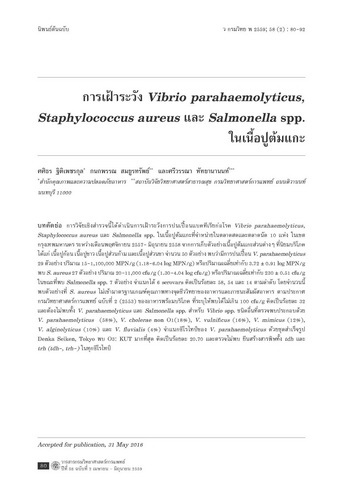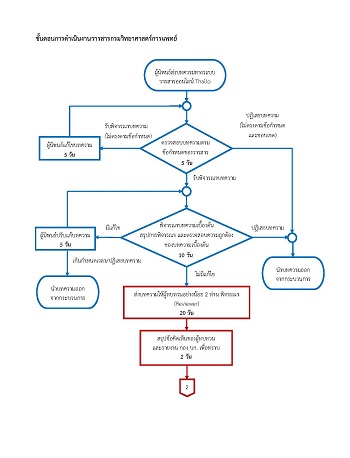Surveillance of Vibrio parahaemolyticus, Staphylococcus aureus and Salmonella spp. in Boiled Crab Meat
Keywords:
Vibrio parahaemolyticus, Staphylococcus aureus, Salmonella spp., Boiled Crab MeatAbstract
This survey research is to monitor the contamination of Vibrio parahaemolyticus, Staphylococcusaureus and Salmonella spp. in boiled crab meats sold in 10 areas of fresh and fair markets of Bangkok district. From the favorite parts for consumption such as lump meat, special meat, claws meat and legs meat, a total of 50 samples during November 2014 till June 2015 were collected for this study. It was found that 29 out of 50 samples were contaminated (58%) with the amount of 15-1,100,000 MPN/g (1.18-6.04 log MPN/g) or the average of 3.72 ± 0.91 log MPN/g of V. parahaemolyticus and 27 out of 50 samples (54%) were contaminated with the amount of 20-11,000 cfu/g (1.30-4.04 log cfu/g) or the average of 230 ± 0.51 cfu/g of S. aureus. Moreover, Salmonella spp. with 6 serovars was detected in 7 samples (14%). From these results, only the amount of S. aureus (32%) was over the specified criteria, stated Microbiological Qualification Standard of Foods and Container notified by Department of Medical Science No. 2 (2553) under the category of ready to eat food, which is less than 100 cfu/g and V. parahaemolyticus as well as Salmonella spp. shall be non-detectable. Various Vibrio spp. of V. parahaemolyticus (58%), V. cholerae non O1 (18%), V. vulnificus (16%), V. mimicus (12%), V. alginolyticus (10%) and V. fluvialis (4%) were found and identified. Concurrently, serotypes of V. parahaemolyticus were classified by using Denka Seikenkit, Tokyo. The most of O3: KUT serotype was found (20.70%), whereas the genes of tdh and trh (tdh-,trh-) were not detected in all serotypes.
References
อาทิชา วงศ์คำมา. โรคอาหารเป็นพิษ. ใน : สรุปรายงานการเฝ้าระวังโรค ประจำปี 2555. กรุงเทพฯ : สำนักระบาดวิทยากรมควบคุมโรค กระทรวงสาธารณสุข; 2555. หน้า 119-121.
อาทิชา วงศ์คำมา, ศรีรัตน์ พรเรืองวงศ์. โรคอาหารเป็นพิษ. ใน : สรุปรายงานการเฝ้าระวังโรค ประจำปี 2556. กรุงเทพฯ : สำนักระบาดวิทยา กรมควบคุมโรค กระทรวงสาธารณสุข; 2556. หน้า 115-117.
อรทัย สุวรรณไชยรบ, สุทธนันธ์ สุทธชนะ, นริศ บุญธนภัทร, ปณิธี ธัมมวิจยะ, กนิน ธีระตันติกานนท์, กมลทิพย์ วิจิตร สุนทรกุล. สถานการณ์โรคและภัยที่น่าสนใจในรอบสัปดาห์ที่ 1 ปี พ.ศ. 2558. รายงานการเฝ้าระวังทางระบาดวิทยาประจำสัปดาห์ 2558; 46(1): 6-7.
Holt JG, Editor. Bergey's manual of determinative bacteriology. 9th ed. Baltimore: Williams & Wilkins; 1994.
Pinto AD, Ciccarese G, Fontanarosa M, Terio V, Tantillo G. Detection of Vibrio alginolyticus and Vibrio parahaemolyticus in shellfish samples using collagenase-targeted multiplex PCR. J Food Safety 2006; 26(2): 150-9.
Kaysner CA, Depaola A. Chapter 9: Vibrio. In: Bacteriological analytical manual online. Washington, DC: Food and Drug Administration; 2004.
Kong RY, Lee SK, Law TW, Law SH, Wu RS. Rapid detection of six types of bacterial pathogens marine waters by multiplex PCR. Water Res 2002; 36(11): 2802-12.
Farmer JJ. The family vibrionaceae. In: Balow A, Truper HG, Dworkin M, Harder W, Schleifer KH, editors. The Prokaryotes: a handbook on the biology of bacteria: ecophysiology, isolation, identification, applications. 2nd ed. New York: Springer Verlag; 1992. p. 2938-2951.
Ottaviani D, Leoni F, Serra R, Serracca L, Decastelli L, Rocchegiani E, et al. Nontoxigenic Vibrio parahaemolyticus strains causing acute gastroenteritis. J Clin Microbiol 2012; 50(12): 4141-3.
Sakazaki R, Iwanami S, Fukumi H. Studies on the enteropathogenic, facultatively halophilic bacteria, Vibrio parahaemolyticus. I. Morphological, cultural and biochemical properties and its taxonomical position. Jpn J Med Sci Biol 1963; 16(4): 161-88.
Sanyal SC, Sen PC. Human volunteer study on the pathogenicity of Vibrio parahaemolyticus. In: Fujino T, Sakaguchi G, Sakazaki R, Takeda Y, editors. International Symposium on Vibrio parahaemolyticus. Tokyo: Saikon Publishing; 1974. p. 227-30.
Kaufman GE, Myers ML, Pass CL, Bej AK, Kaysner CA. Molecular analysis of Vibrio parahaemolyticus isolated from human patients and shellfish during US Pacific north-west outbreaks. Lett Appl Microbiol 2002; 34(3): 155-61.
Wong CH. Detecting and molecular typing of Vibrio parahaemolyticus. J Food Drug Analysis 2003; 11(2): 100-7.
อรษา สุตเธียรกุล, ศุภรวิทย์ พึ่งจิตต์ตน, คล้ายอัปสร พงศ์รพีพร, เนตรนภิส ธีระวัลย์ชัย. การตรวจเชื้อ Vibrio parahaemolyticus และยีนฮีโมไลซินอย่างรวดเร็วในตัวอย่างกุ้งแช่แข็งโดยวิธี Nested PCR. กรุงเทพฯ : สำนักงานคณะกรรมการวิจัยแห่งชาติ (วช); 2544.
Honda T, Iida T. The pathogenicity of Vibrio parahaemolyticus and the role of the thermostable direct haemolysin and related haemolysins. Rev Med Microbiol 1993; 4(2): 106-13.
Nhung PH, Ohkusu K, Miyasaka J, Sun XS, Ezaki T. Rapid and specific identification of 5 human pathogenic Vibrio species by multiplex polymerase chain reaction targeted to dnaJ gene. Diagn Microbiol Infect Dis 2007; 59(3): 271-5.
Jay JM. Chapter 23: Foodborne gastroenteritis caused by Salmonella and Shigella. In: Modern food microbiology. 5th ed. New York: Chapman & Hall; 1996. p. 507-526.
Asiam M, Hogan J, Smith KL. Development of a PCR-based assay to detect Shiga toxin-producing Escherichia coli, Listeria monocytogenes, and Salmonella in milk. Food Microbiol 2003; 20(3): 345-50.
Schwartz KJ. Salmonellosis. In: Straw BE, D’Allaire S, Mengeling WL, Taylor DJ, editors. Diseases of swine. 8th ed. Ames, IW: Iowa State University Press; 1999. p. 535-551.
ศิวาพร ศิวเวช. การสุขาภิบาลโรงงานอุตสาหกรรมอาหาร. พิมพ์ครั้งที่ 5. นครปฐม : ภาควิชาวิทยาศาสตร์และเทคโนโลยีการอาหาร คณะอุตสาหกรรมเกษตร มหาวิทยาลัยเกษตรศาสตร์; 2542.
Bacteriological Analytical Manual Online (BAM). Chapter 12: Staphylococcus aureus. Washington, DC: Food and Drug Administration; 2001.
ISO 6579:2002. Microbiology of food and animal feeding stuffs -- Horizontal method for the detection of Salmonella spp. Geneva, Switzerland: International Organization for Standardization; 2002.
กรมวิทยาศาสตร์การแพทย์. เกณฑ์คุณภาพทางจุลชีววิทยาของอาหารและภาชนะสัมผัสอาหาร ฉบับที่ 2. นนทบุรี : กรมวิทยาศาสตร์การแพทย์ กระทรวงสาธารณสุข; 2553.
Matsumoto C, Okuda J, Ishibashi M, Iwanaga M, Garg P, Rammamurthy T, et al. Pandemic spread of an O3:K6 clone of Vibrio parahaemolyticus and emergence of related strains evidences by arbitrarily primed PCR and toxRS sequence analyses. J Clin Microgiol 2000; 38(2): 578-85.
Okura M, Osawa R, Iguchi A, Arakawa E, Terajima J, Watanabe H, et al. Genotyping analysis of Vibrio parahaemolyticus and development of a pandemic group-specific multiplex PCR assay. J Clin Microbiol 2003; 41(10): 4676-82.
Serichantalergs O, Bhuiyan NA, Nair GB, Chivaratanond O, Srijan A, Bodhidatta L, et al. The dominance of pandemic serovars of Vibrio parahaemolyticus in expatriates and sporadic cases of diarrhea in Thailand, and a new emergent serovar (O3:K46) with pandemic traits. J Med Microbiol 2007; 56(5): 608-13.
Osawa R, Okitsu T, Morozumi H, Yamai S. Occurrence of urease-positive Vibrio parahaemolyticus in Kanagawa, Japan, with specific reference to presence of thermostable direct hemolysin (TDH) and the TDH-related-hemolysin genes. Appl Environ Microbiol 1996; 62(2): 725-7.
Cook DW, Oleary P, Hunsucker JC, Sloan EM, Bowers JC, Blodgett RJ, et al. Vibrio vulnificus and Vibrio parahaemolyticus in U.S. retail shell oysters: a national survey June 1998 to July 1999. J Food Prot 2002; 65: 79-87.
Lin Z, Kumagai K, Baba K, Mekalanos JJ, Nishibuchi M. Vibrio parahaemolyticus has a homolog of the Vibrio cholerae toxRS operon that mediates environmentally induced regulation of the thermostable direct hemolysin gene. J Bacteriol 1993; 175(12): 3844-55.
Miyamoto Y, Kato T, Obara Y, Akiyama S, Takizawa K, Yamai S. In vitro hemolytic characteristic of Vibrio parahaemolyticus: its close correlation with human pathogenicity. J Bacteriol 1969; 100(2): 1147-9.
Vuddhakul V, Chowdhury A, Laohaprertthisan V, Pungrasamee P, Patararungrong N, Thianmontri P, et al. Isolation of pandemic O3:K6 clone of Vibrio parahaemolyticus strain from environmental and clinical sources in Thailand. Appl Environ Microbiol 2000; 66(6): 2685-9.




